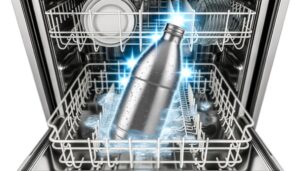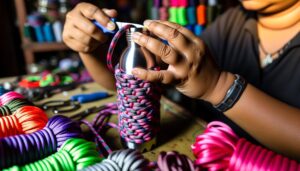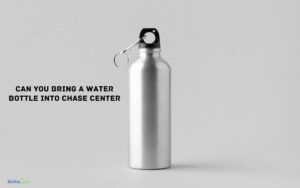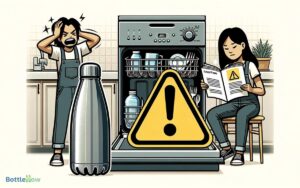How to Clean Pottery Barn Water Bottle? Step by Step Guide!
To clean your Pottery Barn water bottle, start by gathering a soft brush, mild dish soap, white vinegar, and a microfiber cloth.
Disassemble the bottle, unscrewing the lid and any detachable parts. Rinse everything under warm water, ensuring water flows through all components.
Apply mild dish soap to a sponge or brush and scrub the interior and exterior thoroughly. Use a bottle brush for hard-to-reach areas.
Rinse again, inspect for residue, and sanitize if necessary. Dry on a clean towel in a well-ventilated area, then reassemble when completely dry.
This method will keep your water bottle pristine and hygienic. Explore further for detailed care tips.
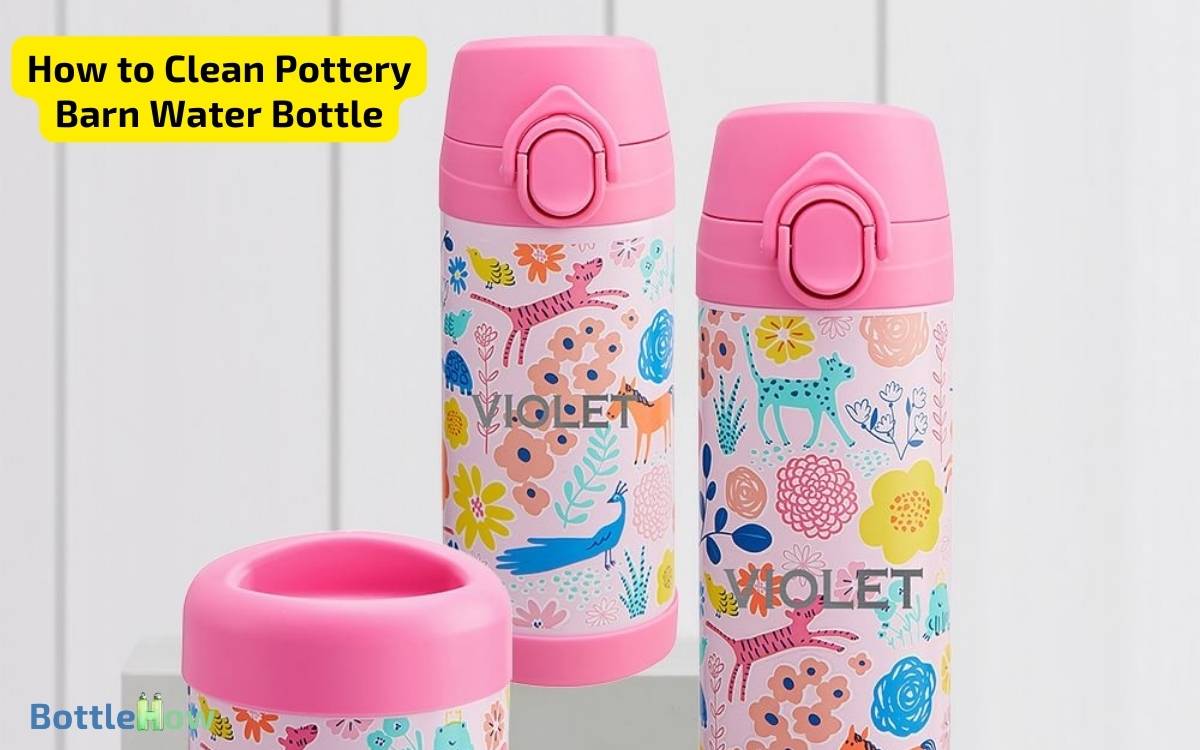
Key Takeaways
Gather Cleaning Supplies
To begin cleaning your Pottery Barn water bottle, you’ll need to gather essential supplies such as a soft brush, mild dish soap, white vinegar, and a microfiber cloth.
- Start by selecting a soft brush, ideally one with bristles that won’t scratch the bottle’s surface.
- Next, choose a mild dish soap to effectively clean without leaving harsh residues.
- White vinegar is essential for its natural disinfecting properties, helping to eliminate any lingering odors or bacteria.
- Finally, a microfiber cloth is perfect for drying and polishing the bottle without leaving lint behind.
Ensuring you have these items beforehand will streamline the cleaning process and enhance your bottle’s longevity.
Gather these supplies to keep your Pottery Barn water bottle in pristine condition.
Disassemble the Bottle
After gathering your cleaning supplies, start by disassembling your Pottery Barn water bottle into its individual components.
- First, unscrew the lid from the bottle. If your bottle has a straw, detach it carefully from the lid.
- Next, if there’s a silicone gasket or seal, remove it gently to avoid any damage. Pay attention to how each piece fits together for easy reassembly later.
- Also, check if there are any additional parts like filters or mouthpieces that need to be taken apart.
- Lay all the components out on a clean surface, ensuring you don’t lose any small parts.
Disassembling the bottle thoroughly will allow you to clean each part more effectively, ensuring your bottle remains hygienic and safe to use.
Rinse With Warm Water
Once you’ve disassembled all the components, rinse each piece thoroughly with warm water to remove any loose debris or residue.
This step is important to make sure that all visible particles are washed away before deeper cleaning.
Follow these steps for an effective rinse:
- Rinse the Bottle: Hold the bottle under a steady stream of warm water, rotating it to make certain all interior surfaces are reached. Pay special attention to the bottom and corners.
- Rinse the Lid: Allow warm water to flow through the lid, especially if it has a spout or straw. Rotate and tilt the lid to access all crevices.
- Rinse Smaller Parts: Submerge any smaller components like seals or gaskets in warm water, agitating them gently to dislodge debris.
This method ensures a thorough preliminary clean.
Use Mild Dish Soap
With the initial rinse complete, apply a few drops of mild dish soap to a sponge or brush to start scrubbing each component of your Pottery Barn water bottle. Make sure the soap is evenly distributed on the cleaning tool.
Gently scrub the bottle’s interior and exterior surfaces, paying close attention to any crevices or grooves where dirt might accumulate.
Don’t forget to clean the cap and any detachable parts, as these areas can harbor bacteria. Use circular motions to lift grime and residue effectively.
Rinse the sponge or brush occasionally to remove loosened debris and reapply soap as needed. This thorough cleaning step will help maintain the bottle’s hygiene and extend its lifespan.
Scrub With a Bottle Brush
Start by choosing an appropriate bottle brush that can reach all areas of the bottle.
Focus particularly on hard-to-reach spots, ensuring you scrub thoroughly to remove any residue. After scrubbing, rinse the bottle well and dry it completely to prevent any moisture buildup.
Choose Appropriate Brush
To effectively clean your Pottery Barn water bottle, select a bottle brush with bristles firm enough to scrub away residue but gentle enough to avoid scratching the interior surface. Choosing the right brush guarantees thorough cleaning without damaging your bottle.
Here’s how to make an informed choice:
- Bristle Material: Opt for nylon or silicone bristles, as they provide a balance between firmness and gentleness.
- Brush Size: Make sure the brush head fits comfortably inside your bottle’s opening for best reach.
- Handle Length: A longer handle allows you to clean the entire bottle, including the base.
Focus on Hard-to-Reach
Make sure you reach every corner of your Pottery Barn water bottle by inserting the brush and scrubbing with firm, consistent strokes.
Pay special attention to the bottom and the area where the bottle curves, as residue often accumulates there.
Use a bottle brush with a long handle and flexible bristles to navigate these tricky spots. Rotate the brush while applying moderate pressure to dislodge any stubborn buildup.
Don’t forget to scrub around the neck and the threading where the cap screws on, as these areas can harbor mold and bacteria. A thorough cleaning guarantees that your water bottle remains hygienic and safe for daily use.
Repeat the process until you’re confident that all areas are spotless.
Rinse and Dry Thoroughly
After scrubbing every part of your Pottery Barn water bottle, rinse it thoroughly under warm running water to remove any soap residue and loosened debris. Make sure water flows through all parts, including the mouthpiece and cap area.
To guarantee complete cleanliness, follow these steps:
- Inspect thoroughly: Check every part for remaining soap or dirt. Pay attention to nooks and crannies.
- Shake excess water: Gently shake the bottle to remove excess water, making certain it doesn’t pool at the bottom.
- Dry completely: Use a clean, dry cloth or air dry by placing the bottle upside down on a drying rack.
Clean the Lid Thoroughly
To clean the lid thoroughly, start by disassembling it to make certain every component is accessible. Use gentle cleaning tools like a soft brush or cloth to avoid damaging any parts.
After cleaning, make sure to dry each piece completely before reassembling to prevent any mold or mildew growth.
Disassemble for Deep Cleaning
Begin by removing the lid from the Pottery Barn water bottle to make sure you can clean all its components thoroughly. Carefully disassemble any removable parts from the lid.
This helps guarantee that you reach every nook and cranny where dirt and bacteria might hide.
Follow these steps:
- Detach the Straw: If your bottle has a straw, gently pull it out from the lid.
- Remove the Gasket: Check for a rubber gasket or seal. Use your fingers or a small tool to remove it carefully.
- Separate Any Additional Parts: Some lids include extra components like flip-tops or spouts. Disassemble these parts to ensure a thorough clean.
Use Gentle Cleaning Tools
Guarantee that the lid and all its components are thoroughly cleaned using a soft brush or sponge to ensure every surface is free of grime and bacteria. Give special attention to crevices and the threading where the lid screws onto the bottle.
Use warm, soapy water to help break down any residue. Avoid using abrasive materials that could scratch or damage the lid’s finish.
For any detachable parts, like seals or straws, make sure they’re thoroughly cleaned by soaking them in soapy water before scrubbing gently. Rinse each component well with clean water to remove any soap residue.
This level of meticulous cleaning guarantees that your Pottery Barn water bottle remains hygienic and safe for use.
Dry Completely Before Reassembly
After cleaning, make certain each component of the lid is completely dry before reassembling to prevent any moisture buildup that could lead to mold or bacterial growth. Pay special attention to all the nooks and crannies where water might hide.
Use a soft, clean cloth to dry every part meticulously. To guarantee thorough drying, consider the following steps:
- Air-Dry Components: Place each part on a clean, dry towel and let them air dry for at least an hour.
- Use a Hairdryer: On a cool setting, gently blow-dry the components to reach difficult spots.
- Inspect for Residual Moisture: Carefully check each piece for any remaining dampness before reassembling.
Focus on Hard-to-Reach Areas
When cleaning the hard-to-reach areas of your Pottery Barn water bottle, you’ll need to use a combination of specialized brushes and cleaning tools to make sure every nook and cranny is thoroughly sanitized.
Start with a long-handled bottle brush to scrub the interior walls and base. For the bottle’s mouth and any narrow openings, a smaller, flexible brush works best.
Don’t forget to clean the cap and any detachable parts; use a toothbrush for intricate grooves and threads. If your bottle has a straw, employ a thin, straw-specific brush to reach inside.
Make sure that you scrub gently but thoroughly, removing any residue or buildup. This meticulous approach will keep your water bottle hygienic and safe for daily use. Pay special attention to the lid and any hard-to-reach areas, as these spots can harbor bacteria if not cleaned properly. For best results, follow guidelines on how to clean Simple Modern bottle to ensure you’re using the right cleaning methods for your specific bottle type. Regular maintenance will not only extend the life of your bottle but also keep your drinks tasting fresh.
Rinse and Inspect
Once you’ve thoroughly scrubbed all components of your Pottery Barn water bottle, it’s crucial to rinse each part meticulously under running water to remove any soap residue.
Pay special attention to areas like the threading on the bottle and lid where soap can easily accumulate.
Follow these steps:
- Rinse Each Component: Hold each part under warm running water, making certain all soap is washed away. Rotate the pieces to catch all angles.
- Inspect for Residue: Check each component closely for any remaining soap or debris. Re-rinse if necessary to guarantee complete cleanliness.
- Dry Thoroughly: After rinsing, shake off excess water and set the parts on a clean towel to air dry. This prevents water spots and ensures your bottle is ready for use.
Sanitize if Needed
To guarantee your Pottery Barn water bottle is free from harmful bacteria, consider using a sanitizing solution for an extra layer of cleanliness.
Begin by filling the bottle with a mixture of one tablespoon of unscented liquid bleach and one quart of water. Secure the lid and shake the bottle vigorously to make sure the solution touches all surfaces.
Allow the solution to sit for at least two minutes, ensuring effective sanitization. Afterward, pour out the bleach solution and rinse the bottle thoroughly with clean water to remove any residual bleach.
For an alternative method, you can use a dishwasher’s sanitizing cycle if your bottle is dishwasher-safe. This approach ensures your bottle remains hygienic and safe for use.
Air Dry Completely
After sanitizing, place your Pottery Barn water bottle in a well-ventilated area to air dry completely.
This step is essential to prevent mold growth and make sure the bottle is thoroughly dry. Use a drying rack or place it upside down on a clean cloth for best results.
Preventing Mold Growth
Guaranteeing your water bottle is completely air-dried is essential in preventing mold growth. Moisture trapped inside the bottle creates an ideal environment for mold to thrive, which can pose health risks.
Follow these steps to ensure thorough drying:
- Disassemble All Parts: Remove the lid, straw, and any other detachable components. This allows each part to dry separately and completely.
- Invert the Bottle: Place the bottle upside down on a clean, dry surface. This position helps drain any residual water and promotes airflow.
- Allow Sufficient Time: Leave the bottle and its parts to air dry for at least 24 hours. Rushing this process can leave moisture behind, inviting mold growth.
Adhering to these steps will help keep your water bottle safe and mold-free.
Ensuring Complete Drying
Disassembling your water bottle and placing each part in a well-ventilated area guarantees every component dries completely and thoroughly. After cleaning, separate the lid, straw, and any removable seals.
Lay them on a clean, dry towel in a location with good air circulation. Avoid areas with high humidity, as they can impede the drying process.
Make sure all parts are positioned to allow maximum air exposure—standing the bottle upside down helps drain excess water.
Check periodically to confirm no moisture remains, especially in hard-to-reach spots. Allow ample time, typically several hours, for complete drying.
Once dry, reassemble the bottle, making sure it’s free from any lingering dampness, which could promote mold growth. This method guarantees your water bottle remains hygienic and ready for use.
Using Proper Technique
Proper technique for air-drying your Pottery Barn water bottle guarantees that every component is thoroughly dried, preventing mold and bacteria growth.
Follow these steps to achieve the best results:
- Disassemble Completely: Remove the lid, gasket, and any other detachable parts. Lay them out separately to make sure every piece dries fully.
- Position Correctly: Place the bottle upside down on a drying rack or a clean, dry towel. This allows water to drain out and air to circulate inside.
- Allow Sufficient Time: Leave all parts to air dry for at least 24 hours. Ensure they’re placed in a well-ventilated area to speed up the drying process.
Reassemble and Store
Once all the components are thoroughly dry, carefully reassemble the water bottle by aligning and securing each part in its correct position.
Make sure the lid fits snugly, the straw is properly inserted, and any gaskets or seals are correctly placed to prevent leaks. Double-check that all connections are tight, but avoid over-tightening to prevent damage.
For storage, keep the water bottle in a clean, dry place to maintain its hygiene. Store it upright to allow any residual moisture to evaporate and avoid potential mold growth.
If you’re not using the bottle for an extended period, consider leaving the lid slightly loose to allow airflow.
Proper reassembly and storage will extend the life of your Pottery Barn water bottle.
Conclusion
Congratulations, you’ve now mastered the fine art of cleaning your Pottery Barn water bottle, an endeavor that surely rivals the complexity of fine wine production.
You’ve gathered supplies, disassembled parts, scrubbed with the precision of a surgeon, and sanitized like a germaphobe.
Now, as your pristine bottle air dries, bask in the satisfaction of knowing you’ve achieved a level of cleanliness that only the most discerning water connoisseurs will appreciate.
Cheers to your sparkling hydration vessel!


